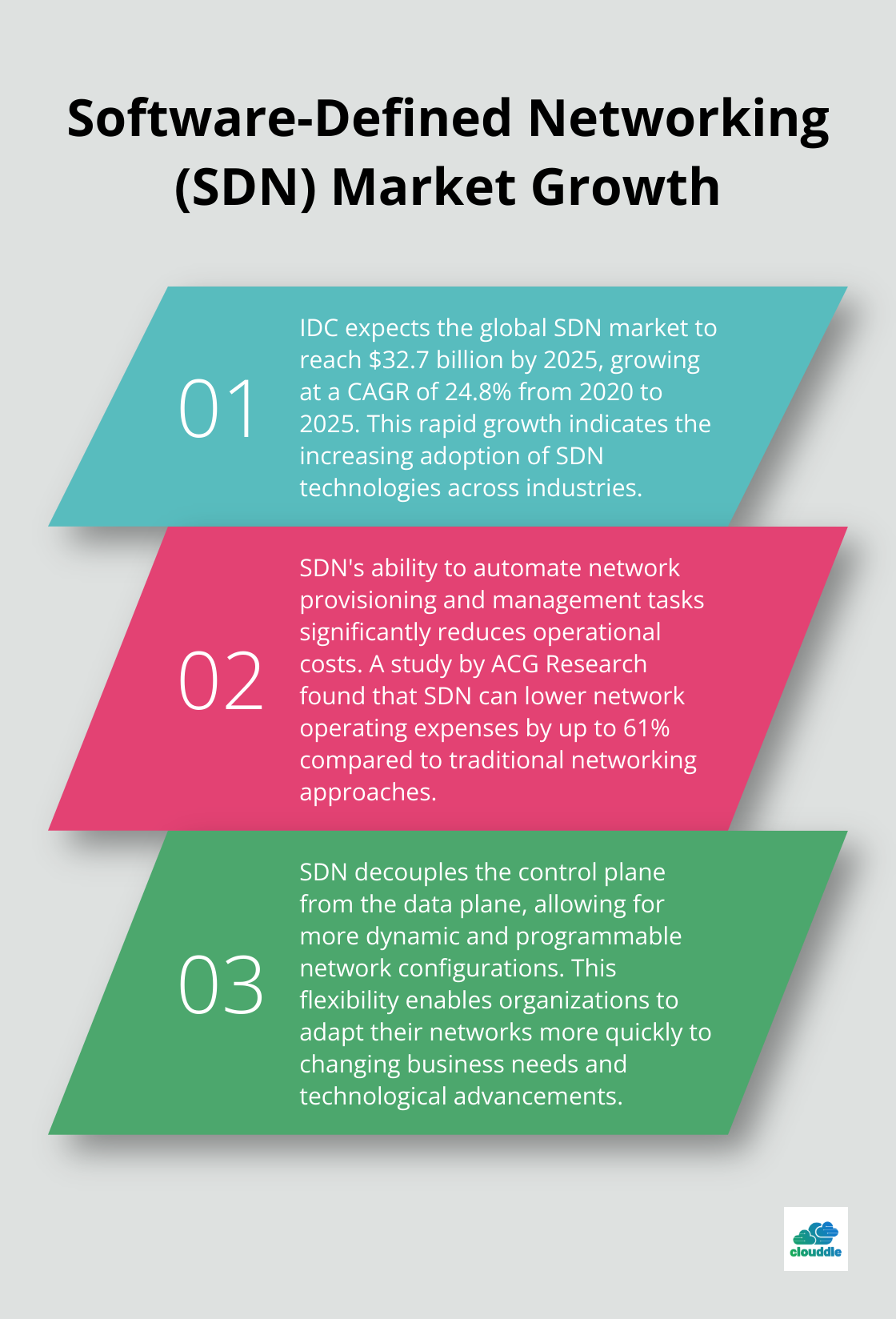In today’s digital landscape, effective network management and security are paramount for businesses of all sizes. The increasing complexity of IT infrastructures and the growing sophistication of cyber threats demand robust strategies to protect critical assets.
At Clouddle, we understand the challenges organizations face in maintaining secure and efficient networks. This blog post explores key strategies and emerging technologies that can help you safeguard your network infrastructure while optimizing performance.
Mastering Network Fundamentals
Mapping Your Network Landscape
The first step in mastering network management requires a comprehensive understanding of your network topology. This involves creating a detailed map of all devices, connections, and data flows within your organization. Network mapping software can provide visual representations of your infrastructure, making it easier to identify potential bottlenecks or vulnerabilities.
According to recent surveys, 75% of organizations noted that having detailed network maps significantly improved their performance during incident responses. This underscores the importance of regular updates to your network documentation to reflect infrastructure changes.

Essential Components for Effective Management
Implementing the right set of management tools is vital for maintaining network health. Network monitoring software, configuration management databases (CMDB), and performance analytics platforms form the core of a robust management strategy.
A Gartner study showed that organizations using integrated network management platforms experienced 35% fewer outages compared to those relying on disparate tools. This highlights the value of adopting a unified approach to network management.
The Power of Proactive Monitoring
Proactive monitoring prevents network issues before they impact your business. Continuous analysis of network performance metrics allows you to identify trends and address potential problems early.
Implementing automated alerts for unusual traffic patterns or device failures can significantly reduce response times. The Internet Engineering Task Force (IETF) recommends setting up threshold-based alerts for critical metrics such as bandwidth utilization, latency, and packet loss.
Regular Network Health Checks
Scheduling regular network health checks ensures optimal performance. These checks should include reviewing firewall rules, updating device firmware, and verifying backup systems. A proactive stance minimizes downtime and maintains a resilient network infrastructure.
Adapting to Evolving Technologies
Effective network management requires constant attention and adaptation to evolving technologies and threats. Staying informed about the latest advancements in network management tools and techniques (such as AI-driven analytics and software-defined networking) allows organizations to stay ahead of potential challenges.
As we move forward, let’s explore how these fundamental network management principles intersect with crucial security practices to create a comprehensive strategy for protecting your digital assets.
Fortifying Your Network Against Cyber Threats
Layered Defense Strategy
A multi-layered approach to security forms the backbone of robust network protection. Next-generation firewalls (NGFWs) offer more than traditional packet filtering. They provide deep packet inspection, intrusion prevention, and application-level filtering. Traditional firewalls and NGFWs both incorporate core firewall capabilities and play a similar role in a corporate cybersecurity architecture.
Pair your firewall with an advanced intrusion detection system (IDS) to monitor network traffic for suspicious activities. Modern IDS solutions use machine learning algorithms to detect anomalies and potential threats in real-time.
Continuous Security Assessments
Regular security audits and vulnerability assessments maintain a strong security posture. Conduct monthly internal scans and quarterly external penetration tests to identify weaknesses in your network. Tools like Nessus or OpenVAS automate much of this process, but don’t rely solely on automated scans.
Engage certified ethical hackers for manual testing at least once a year.
Human Firewall: Employee Training
Your employees can be your greatest asset or your biggest security risk. This statistic underscores the importance of comprehensive cybersecurity training.
Implement a continuous learning program that goes beyond annual compliance training. Use phishing simulation tools to test and educate employees regularly.
Consider gamifying your security training. Platforms like Cybrary or Hack The Box offer engaging, hands-on learning experiences that can transform your employees into cyber-defenders.

Emerging Trends in Network Security
As cyber threats evolve, so must your defenses. AI and machine learning now play a significant role in threat detection and response. These technologies can analyze vast amounts of data to identify patterns and anomalies that human analysts might miss.
Zero Trust Architecture (ZTA) has gained traction as a security model. ZTA is an enterprise cybersecurity architecture based on zero trust principles and designed to prevent data breaches.
The rise of cloud computing has led to the development of Cloud Access Security Brokers (CASBs). These tools provide visibility into cloud usage and help enforce security policies across multiple cloud services.
As we move forward, the integration of these advanced security measures with effective network management becomes increasingly important. Let’s explore how emerging technologies are shaping the future of network management and security.
How AI and SDN Reshape Network Management
AI and ML: The New Network Guardians
Artificial intelligence (AI) and machine learning (ML) have transformed from buzzwords into essential tools for network optimization. These technologies analyze vast amounts of data to identify patterns and anomalies that human operators often miss. Juniper Networks reports that their AI-driven network management solution reduced network-related trouble tickets by up to 90% for their customers.
Network administrators now use AI-powered tools to predict and prevent outages before they occur. Gartner predicts that by 2026, 70% of organizations will use AI for IT operations (AIOps) platforms to enhance IT service management and automation, up from 5% in 2021.
SDN: Flexibility Meets Efficiency
Software-defined networking (SDN) has emerged as a game-changer for network flexibility and management. SDN decouples the control plane from the data plane, which allows for more dynamic and programmable network configurations. IDC expects the global SDN market to reach $32.7 billion by 2025, growing at a CAGR of 24.8% from 2020 to 2025.
SDN’s ability to automate network provisioning and management tasks significantly reduces operational costs. A study by ACG Research found that SDN can lower network operating expenses by up to 61% compared to traditional networking approaches.

Cloud-Based Network Management: Scalability on Demand
The shift towards cloud-based network management solutions continues to gain momentum. These platforms offer unparalleled scalability and accessibility, which allows IT teams to manage networks from anywhere in the world. Cisco’s Annual Internet Report predicts that by 2025, 51% of all network devices and connections will be in the cloud.
Cloud-based solutions also facilitate better integration with other cloud services and applications. This integration proves vital as organizations increasingly adopt multi-cloud strategies. A survey by Flexera found that 92% of enterprises have a multi-cloud strategy, which emphasizes the need for cloud-native network management tools.
The Future of Network Management
As these technologies mature, we can expect even more sophisticated network management capabilities. Organizations must stay informed and agile to adopt these innovations and maintain a competitive edge in an increasingly connected world.
AI and ML will continue to improve threat detection and response times, while SDN will offer greater network flexibility and efficiency. Cloud-based solutions will provide scalable and accessible management options, catering to the growing trend of remote work and distributed teams.
Final Thoughts
Effective network management and security form the cornerstone of a successful digital strategy. Organizations must adapt to the ever-changing landscape of technology, embracing AI, machine learning, and software-defined networking to optimize performance and enhance security. These advancements offer unprecedented opportunities to streamline operations and protect digital assets.
We at Clouddle understand the complexities of modern network infrastructure. Our Network as a Service (NaaS) solutions combine advanced networking, entertainment, and security features to empower businesses across various industries. You can focus on your core business while we handle the intricacies of network management and security.
A proactive approach to network management and security is essential. Regular audits, employee training, and the adoption of advanced tools (such as AI-driven analytics) will help you build a robust and efficient network infrastructure. This approach will support your organization’s growth and maintain your competitive edge in today’s fast-paced business environment.


